
Algae are any of a large and diverse group of photosynthetic, eukaryotic organisms. The name is an informal term for a polyphyletic grouping that includes species from multiple distinct clades. Included organisms range from unicellular microalgae, such as Chlorella, Prototheca and the diatoms, to multicellular forms, such as the giant kelp, a large brown alga which may grow up to 50 metres (160 ft) in length. Most are aquatic and lack many of the distinct cell and tissue types, such as stomata, xylem and phloem that are found in land plants. The largest and most complex marine algae are called seaweeds, while the most complex freshwater forms are the Charophyta, a division of green algae which includes, for example, Spirogyra and stoneworts. Algae that are carried by water are plankton, specifically phytoplankton.

Phycology is the scientific study of algae. Also known as algology, phycology is a branch of life science.
Pyropia columbina, Southern laver, karengo in the Māori language and luche in the Spanish language, is a species of edible seaweed traditionally harvested by South Island Māori in New Zealand and Chilote people in Chile. It is closely related to Japanese Nori and Welsh laverbread.
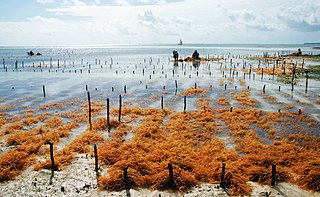
Algaculture is a form of aquaculture involving the farming of species of algae.

Phycologia Australica, written by William Henry Harvey, is one of the most important 19th-century works on phycology, the study of algae.
The history of phycology is the history of the scientific study of algae. Human interest in plants as food goes back into the origins of the species, and knowledge of algae can be traced back more than two thousand years. However, only in the last three hundred years has that knowledge evolved into a rapidly developing science.

Postelsia palmaeformis, also known as the sea palm or palm seaweed, is a species of kelp and classified within brown algae. It is the only known species in the genus Postelsia. The sea palm is found along the western coast of North America, on rocky shores with constant waves. It is one of the few algae that can survive and remain erect out of the water; in fact, it spends most of its life cycle exposed to the air. It is an annual, and edible, though harvesting of the alga is discouraged due to the species' sensitivity to overharvesting.

Colpomenia peregrina, sometimes referred to by its vernacular names oyster thief and bladder weed, is a species of brown seaweed.
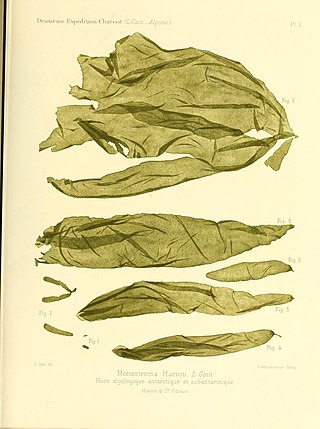
Monostroma is a genus of marine green algae (seaweed) in the family Monostromataceae. As the name suggests, algae of this genus are monostromatic. Monostroma kuroshiense, an algae of this genus, is commercially cultivated in East Asia and South America for the edible product "hitoegusa-nori" or "hirohano-hitoegusa nori", popular sushi wraps. Monostroma oligosaccharides with degree of polymerization 6 prepared by agarase digestion from Monostroma nitidum polysaccharides have been shown to be an effective prophylactic agent during in vitro and in vivo tests against Japanese encephalitis viral infection. The sulfated oligosaccharides from Monostroma seem to be promising candidates for further development as antiviral agents. The genus Monostroma is the most widely cultivated genus among green seaweeds.

Gelidium is a genus of thalloid red algae comprising 134 species. Its members are known by a number of common names.

Edible seaweed, or sea vegetables, are seaweeds that can be eaten and used for culinary purposes. They typically contain high amounts of fiber. They may belong to one of several groups of multicellular algae: the red algae, green algae, and brown algae. Seaweeds are also harvested or cultivated for the extraction of polysaccharides such as alginate, agar and carrageenan, gelatinous substances collectively known as hydrocolloids or phycocolloids. Hydrocolloids have attained commercial significance, especially in food production as food additives. The food industry exploits the gelling, water-retention, emulsifying and other physical properties of these hydrocolloids.
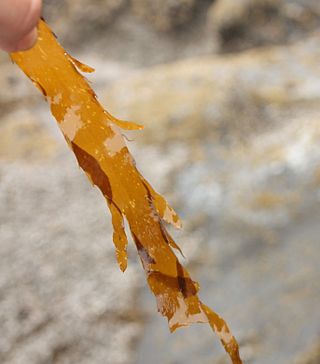
Desmarestiaceae is a family of brown algae, one of two families in the order Desmarestiales. The family gets its name from the genus Desmarestia, which is named after the French zoologist Anselme Gaëtan Desmarest (1784-1838).

Desmarestia is a genus of brown algae found worldwide. It is also called acid weed, acidweed, oseille de mer, sea sorrel, ウルシグサ, stacheltang, mermaid's hair, landlady's wig, or gruagach. However, 'sea sorrel' can also specifically refer to Desmarestia viridis. Members of this genus can be either annual or perennial. Annual members of this genus store sulfuric acid in intracellular vacuoles. When exposed to air they release the acid, thereby destroying themselves and nearby seaweeds in the process. They are found in shallow intertidal zones.
Egil Morris Baardseth was a Norwegian botanist and phycologist.

Desmarestia tropica, sometimes called tropical acidweed, is a species of seaweed in the family Desmarestiaceae. It is critically endangered, possibly extinct, and one of only fifteen protists evaluated by IUCN. Endemic to the Galápagos Islands, the specific epithet tropica alludes to its tropical habitat, rare for members of Desmarestiales. The common name acidweed applies to members of the genus Desmarestia, generally characterized by fronds containing vacuoles of concentrated sulfuric acid, but it is unclear if this species also produces acid.
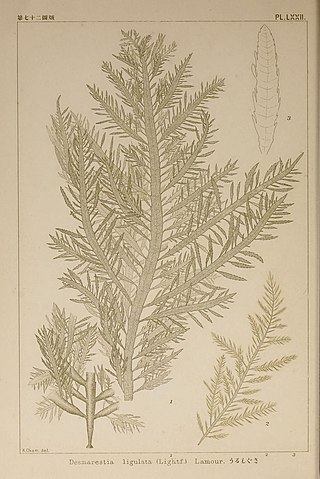
Desmarestia ligulata is a species of brown algae found worldwide. Its common names include color changer, Desmarest's flattened weed, and sea sorrel, though the last name can also refer to other species of Desmarestia.
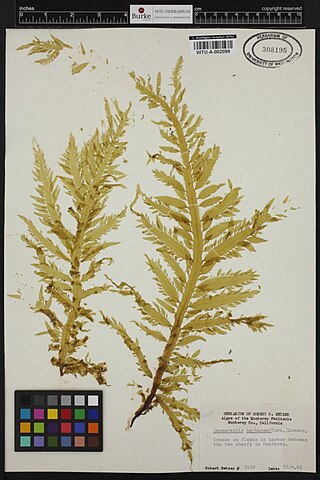
Desmarestia herbacea is a species of brown algae found worldwide. Its common names include color changer, Desmarest's flattened weed, and sea sorrel, though the last name can also refer to other species of Desmarestia.
Margaret Constance Helen Blackler (1902–1981) was a British phycologist, botanical collector and museum curator.
Mary Wyatt (1789–1871) was a British botanist, phycologist and retailer from Torquay, Devon. She was the compiler of the respected Algae Danmoniensis - a collection, i.e. exsiccata, of seaweeds to which William Henry Harvey later considered his Manual of the British Algae (1841) a 'companion' work. Wyatt helped to fuel the Victorian 'seaweed craze' for collecting. The tongue twister 'She Sells Seashells on the Sea Shore' was possibly inspired by Wyatt and her close companion Amelia Griffiths, with whom she collected seaweed and sea shells in Devon.



















